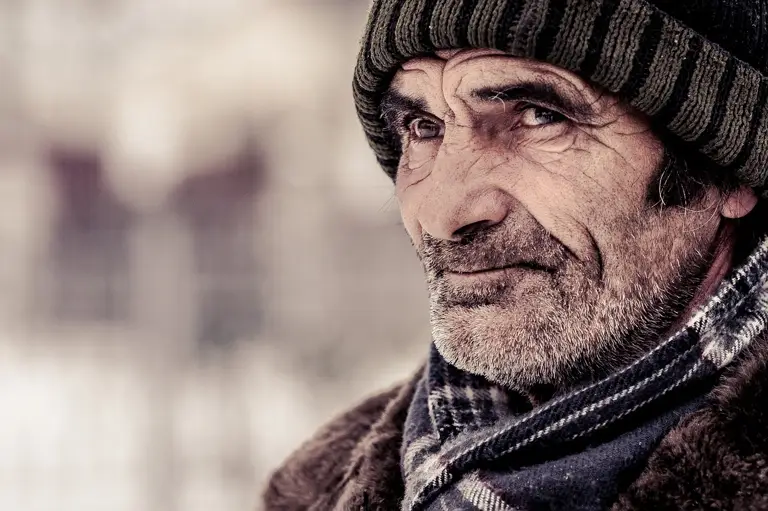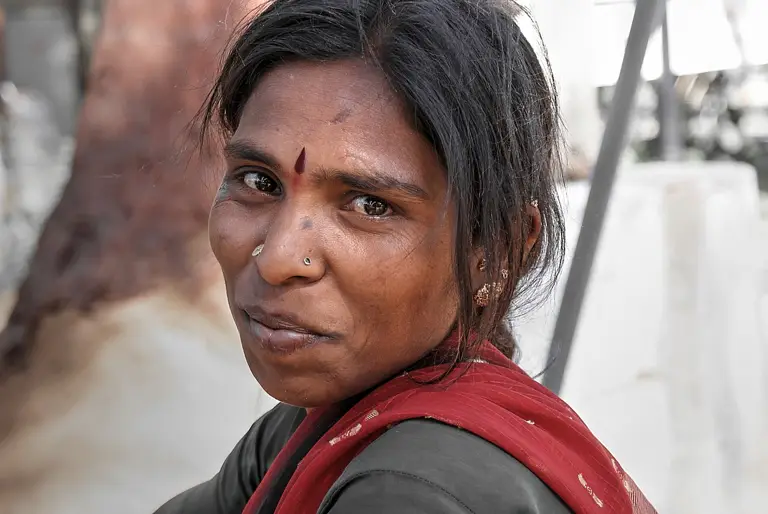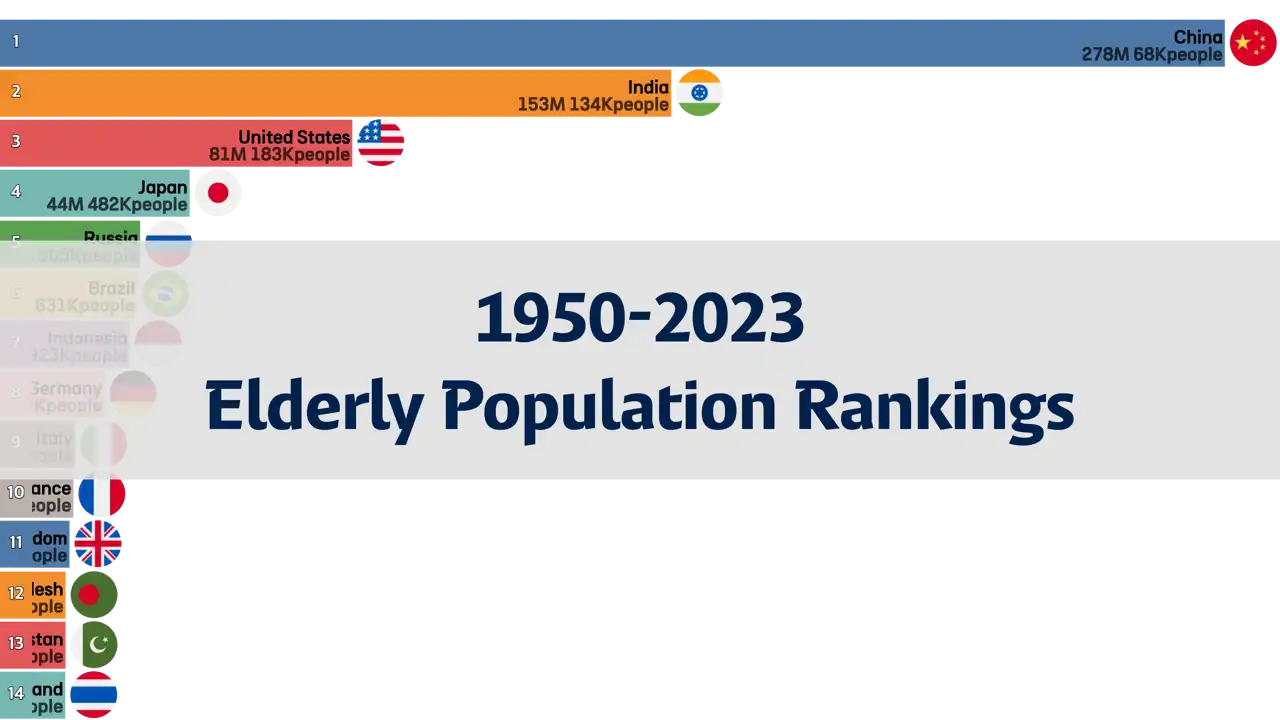
Top 10 Countries with the Largest Elderly Population in 2023: Where Aging is Redefining Society
- ASUMUP
- National Rankings
- August 14, 2024
As the global population continues to age, understanding the distribution of the elderly across different countries becomes increasingly important. In 2023, several nations stand out for their significant populations of individuals aged 60 and above. These figures not only reflect demographic trends but also have profound implications for each country's economy, healthcare system, and social structure. In this post, we'll delve into the top 10 countries with the largest elderly populations in 2023, exploring the reasons behind these numbers and what they mean for the future.
Top 10 Countries with Most Elderly Population
- 1st China - 278.1 million
- 2nd India - 153.1 million
- 3rd United States of America - 81.2 million
- 4th Japan - 44.5 million
- 5th Russian Federation - 33.3 million
- 6th Brazil - 32.6 million
- 7th Indonesia - 30.9 million
- 8th Germany - 25.2 million
- 9th Italy - 18.6 million
- 10th France - 18.2 million
10th France - 18.2 million
France has an elderly population of approximately 18.2 million, ranking tenth in the world. France's aging population is the result of high life expectancy and relatively low birth rates. The country has a well-developed social welfare system that includes comprehensive healthcare and pension systems. However, France still faces challenges in managing the increasing costs associated with an aging population. The government has been implementing reforms to ensure the sustainability of the pension system and to improve healthcare services for the elderly. Additionally, there is a growing emphasis on promoting active aging, where older citizens are encouraged to remain engaged in the workforce and society for as long as possible.
9th Italy - 18.6 million
Italy has an elderly population of about 18.6 million, making it the ninth largest in the world. The country's aging population is a result of low birth rates and high life expectancy, leading to a super-aged society. Italy faces several challenges with its aging population, including the sustainability of its pension system, the provision of healthcare, and the need for adequate elderly care services. The economic and social implications of this demographic shift are significant, with a shrinking workforce and increasing demand for elderly care. Italy has been exploring various policy options to address these challenges, including encouraging higher fertility rates and increasing support for families and the elderly.
8th Germany - 25.2 million
Germany's elderly population is around 25.2 million, placing it eighth globally. Germany’s aging population is a result of low birth rates and high life expectancy, similar to other developed countries. The country has implemented several measures to address the challenges of an aging society, including pension reforms, healthcare system adjustments, and promoting longer working lives. Germany’s approach to elderly care emphasizes social insurance models, where both public and private sectors play a role in providing care. However, the country still faces challenges, particularly in ensuring that the elderly can live independently for as long as possible and in addressing the increasing costs of healthcare and pensions.
7th Indonesia - 30.9 million
Indonesia has an elderly population of about 30.9 million, making it the seventh largest in the world. The country’s rapidly aging population is a result of declining birth rates and improvements in healthcare that have increased life expectancy. Indonesia faces several challenges with its aging population, including limited access to healthcare services, especially in rural areas, and insufficient social security for the elderly. The traditional family-based care system is under strain due to urbanization and changing social dynamics. The Indonesian government has recognized these challenges and is working on policies to improve healthcare access and provide better support for its aging population. However, significant efforts are still needed to meet the growing demands of its elderly citizens.
6th Brazil - 32.6 million
Brazil's elderly population stands at approximately 32.6 million, placing it sixth worldwide. Brazil's aging demographic is driven by decreasing birth rates and increasing life expectancy, similar to trends seen in other parts of the world. The country faces significant challenges in providing adequate healthcare, social security, and retirement benefits for its elderly population. Economic inequality in Brazil also means that access to elderly care varies widely across different regions and income levels. The government is under pressure to develop policies that address these disparities and ensure that the aging population receives the support it needs. As Brazil continues to develop, how it handles the needs of its elderly citizens will be a critical factor in its social and economic progress.
5th Russian Federation - 33.3 million
The Russian Federation has an elderly population of approximately 33.3 million, ranking fifth globally. The aging population in Russia is a reflection of both the decline in birth rates after the Soviet Union's dissolution and improvements in life expectancy. Russia faces several challenges with its aging population, including the sustainability of its pension system, healthcare provision, and the socio-economic integration of elderly citizens. The country's vast geography and regional disparities also mean that elderly care and services vary significantly across different areas. Addressing these issues is crucial for Russia as it navigates the complexities of an aging society while striving to maintain economic stability.
4th Japan - 44.5 million
Japan has one of the world's highest proportions of elderly citizens, with 44.5 million people aged 60 and above. Japan's aging population is the result of decades of low birth rates and high life expectancy, making it a super-aged society. The country faces profound challenges due to its aging demographic, including a shrinking workforce, increasing healthcare costs, and the need for comprehensive elderly care services. Japan's government has been proactive in addressing these issues through various reforms, including encouraging higher participation of women and older workers in the labor force and investing in technology to support elderly care. However, the demographic shift continues to pose a significant strain on Japan’s economy and social systems.
3rd United States of America - 81.2 million
The United States has approximately 81.2 million people aged 60 and above, placing it third in the world for elderly population size. This significant demographic reflects the country's baby boomer generation, who are now entering retirement age. The U.S. faces unique challenges with its aging population, including the rising costs of healthcare, the sustainability of Social Security, and the need for affordable senior housing. Moreover, the increasing elderly population is influencing the labor market, with more seniors either remaining in or re-entering the workforce. The U.S. is at a pivotal point where the policies and support systems implemented now will have long-lasting impacts on the aging society.
2nd India - 153.1 million
India has the second-largest elderly population in the world, with approximately 153.1 million people aged 60 and over. The country's large population base and increasing life expectancy contribute to this significant number. Unlike China, India does not have a strict family planning policy, but it faces similar challenges as its population ages. The healthcare infrastructure, social security, and the traditional joint family system, which has long served as the primary support for the elderly, are under pressure. The rise in nuclear families and urbanization is leading to a growing need for institutional care and government support for the elderly. As the elderly population increases, India must address these challenges to ensure the well-being of its aging citizens.
1st China - 278.1 million
China leads the world in terms of its elderly population, with a staggering 278.1 million people aged 60 and above. This number is a direct consequence of the country's one-child policy, which has significantly reduced the younger population while the older generation continues to grow. Additionally, advancements in healthcare and living standards have increased life expectancy. The rapid aging of China’s population presents significant challenges, including the need for a robust elderly care system, pension reform, and adjustments to the workforce as the country’s demographic pyramid inverts. Social and economic policies are urgently needed to address these shifts, as the aging population could strain China's economic growth if not managed effectively.
Other Posts in the National Rankings
Categories
- National Rankings(43)
- Science & Technology(1)
- Sports(24)
- Economy(30)
- Society(12)
- Culture(7)
Recent Posts
![Bayern Spent HOW MUCH on Harry Kane?! Ranking Their Top 10 Biggest Signings Ever]() A deep dive into Bayern Munich's ten most expensive transfers, exploring how the club's spending strategy has evolved to chase European glory.
A deep dive into Bayern Munich's ten most expensive transfers, exploring how the club's spending strategy has evolved to chase European glory.![Arsenal's Record-Shattering Spree: From a €116M Gamble to a Flop, Who Was Worth the Cash?]() A deep dive into Arsenal's top 10 most expensive signings, analyzing the successes, the failures, and the massive fees that have defined the club's modern transfer strategy.
A deep dive into Arsenal's top 10 most expensive signings, analyzing the successes, the failures, and the massive fees that have defined the club's modern transfer strategy.![Chelsea Cashes In BIG TIME! Who Really Won the 25/26 Summer Transfer Window Money Game?]() A deep dive into the top 10 clubs that made the most money from player sales during the wild 25/26 summer transfer window.
A deep dive into the top 10 clubs that made the most money from player sales during the wild 25/26 summer transfer window.![Liverpool's Record-Breaking €483M Spree! Did They Just Buy the Premier League Title?]() A deep dive into the 25/26 summer transfer window reveals Liverpool's record-breaking spending spree as Premier League clubs continue to dominate the market.
A deep dive into the 25/26 summer transfer window reveals Liverpool's record-breaking spending spree as Premier League clubs continue to dominate the market.![You Won't Believe How Much a Loaf of Bread Costs in These Countries! (Spoiler: It's INSANE)]() This post explores the top 10 countries with the most expensive bread, revealing how factors like import reliance and tourism dramatically inflate the cost of this basic staple.
This post explores the top 10 countries with the most expensive bread, revealing how factors like import reliance and tourism dramatically inflate the cost of this basic staple.
















